Module Name: International Expansion Strategy - Assessment Report
VerifiedAdded on 2023/06/04
|13
|4285
|173
Report
AI Summary
This report provides a comprehensive analysis of international expansion strategies for a major Australian bank, focusing on market opportunities in France, Brazil, and South Korea. The analysis includes an overview of each market's economic structure, potential size and profitability, and potential problems in selling and supporting the market. The report also examines the future developments of each market, including factors such as GDP growth, economic freedom, and financial sector stability. Furthermore, the report offers recommendations for the bank's international expansion strategy, taking into account the challenges and opportunities presented by each market. The report also considers factors such as competitive landscapes and the need for innovation and commitment to succeed in the markets. The report is based on the assignment brief from the CEO of the bank, requiring assessment of each market and recommendations for future actions, as well as a formal title page and adherence to a 3000-word limit.
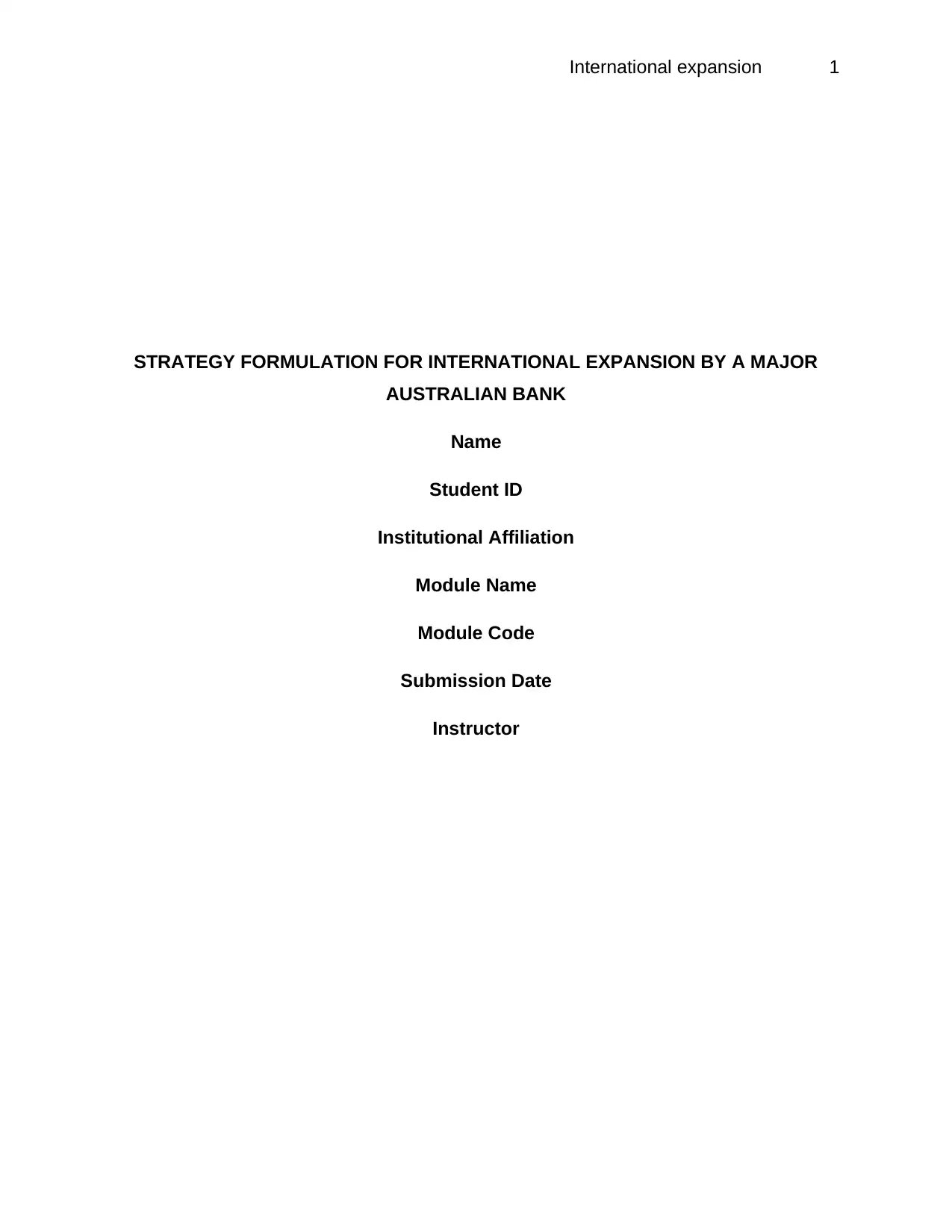
International expansion 1
STRATEGY FORMULATION FOR INTERNATIONAL EXPANSION BY A MAJOR
AUSTRALIAN BANK
Name
Student ID
Institutional Affiliation
Module Name
Module Code
Submission Date
Instructor
STRATEGY FORMULATION FOR INTERNATIONAL EXPANSION BY A MAJOR
AUSTRALIAN BANK
Name
Student ID
Institutional Affiliation
Module Name
Module Code
Submission Date
Instructor
Paraphrase This Document
Need a fresh take? Get an instant paraphrase of this document with our AI Paraphraser
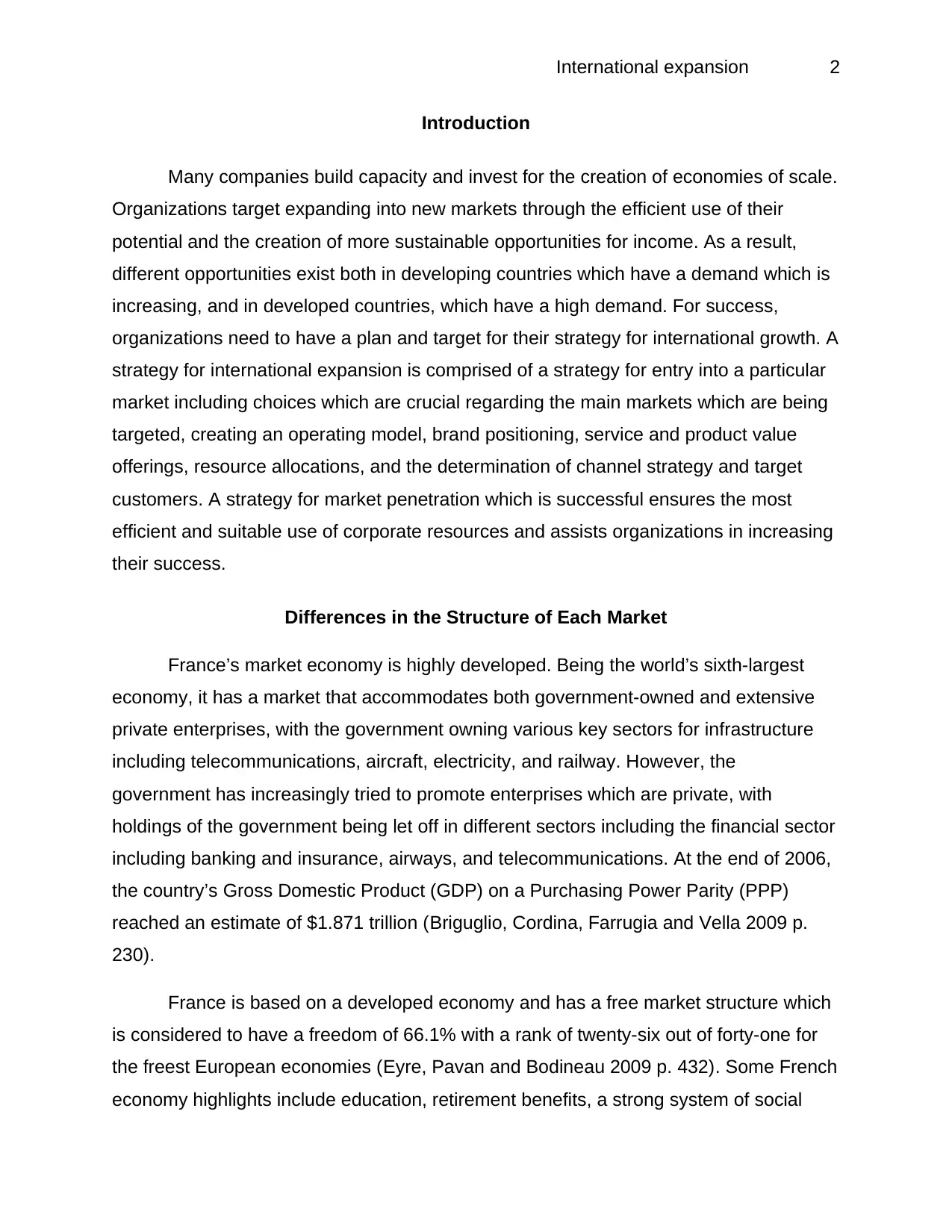
International expansion 2
Introduction
Many companies build capacity and invest for the creation of economies of scale.
Organizations target expanding into new markets through the efficient use of their
potential and the creation of more sustainable opportunities for income. As a result,
different opportunities exist both in developing countries which have a demand which is
increasing, and in developed countries, which have a high demand. For success,
organizations need to have a plan and target for their strategy for international growth. A
strategy for international expansion is comprised of a strategy for entry into a particular
market including choices which are crucial regarding the main markets which are being
targeted, creating an operating model, brand positioning, service and product value
offerings, resource allocations, and the determination of channel strategy and target
customers. A strategy for market penetration which is successful ensures the most
efficient and suitable use of corporate resources and assists organizations in increasing
their success.
Differences in the Structure of Each Market
France’s market economy is highly developed. Being the world’s sixth-largest
economy, it has a market that accommodates both government-owned and extensive
private enterprises, with the government owning various key sectors for infrastructure
including telecommunications, aircraft, electricity, and railway. However, the
government has increasingly tried to promote enterprises which are private, with
holdings of the government being let off in different sectors including the financial sector
including banking and insurance, airways, and telecommunications. At the end of 2006,
the country’s Gross Domestic Product (GDP) on a Purchasing Power Parity (PPP)
reached an estimate of $1.871 trillion (Briguglio, Cordina, Farrugia and Vella 2009 p.
230).
France is based on a developed economy and has a free market structure which
is considered to have a freedom of 66.1% with a rank of twenty-six out of forty-one for
the freest European economies (Eyre, Pavan and Bodineau 2009 p. 432). Some French
economy highlights include education, retirement benefits, a strong system of social
Introduction
Many companies build capacity and invest for the creation of economies of scale.
Organizations target expanding into new markets through the efficient use of their
potential and the creation of more sustainable opportunities for income. As a result,
different opportunities exist both in developing countries which have a demand which is
increasing, and in developed countries, which have a high demand. For success,
organizations need to have a plan and target for their strategy for international growth. A
strategy for international expansion is comprised of a strategy for entry into a particular
market including choices which are crucial regarding the main markets which are being
targeted, creating an operating model, brand positioning, service and product value
offerings, resource allocations, and the determination of channel strategy and target
customers. A strategy for market penetration which is successful ensures the most
efficient and suitable use of corporate resources and assists organizations in increasing
their success.
Differences in the Structure of Each Market
France’s market economy is highly developed. Being the world’s sixth-largest
economy, it has a market that accommodates both government-owned and extensive
private enterprises, with the government owning various key sectors for infrastructure
including telecommunications, aircraft, electricity, and railway. However, the
government has increasingly tried to promote enterprises which are private, with
holdings of the government being let off in different sectors including the financial sector
including banking and insurance, airways, and telecommunications. At the end of 2006,
the country’s Gross Domestic Product (GDP) on a Purchasing Power Parity (PPP)
reached an estimate of $1.871 trillion (Briguglio, Cordina, Farrugia and Vella 2009 p.
230).
France is based on a developed economy and has a free market structure which
is considered to have a freedom of 66.1% with a rank of twenty-six out of forty-one for
the freest European economies (Eyre, Pavan and Bodineau 2009 p. 432). Some French
economy highlights include education, retirement benefits, a strong system of social
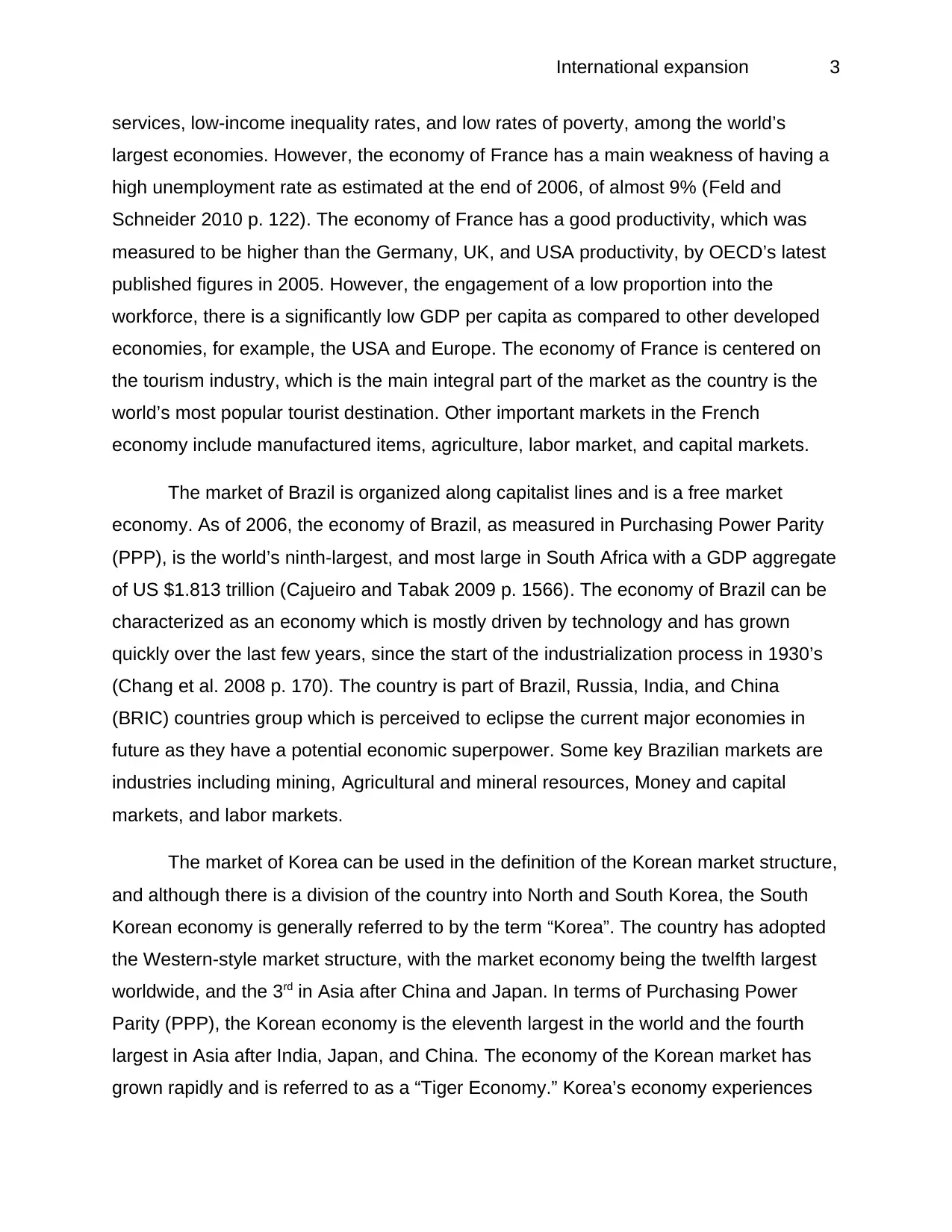
International expansion 3
services, low-income inequality rates, and low rates of poverty, among the world’s
largest economies. However, the economy of France has a main weakness of having a
high unemployment rate as estimated at the end of 2006, of almost 9% (Feld and
Schneider 2010 p. 122). The economy of France has a good productivity, which was
measured to be higher than the Germany, UK, and USA productivity, by OECD’s latest
published figures in 2005. However, the engagement of a low proportion into the
workforce, there is a significantly low GDP per capita as compared to other developed
economies, for example, the USA and Europe. The economy of France is centered on
the tourism industry, which is the main integral part of the market as the country is the
world’s most popular tourist destination. Other important markets in the French
economy include manufactured items, agriculture, labor market, and capital markets.
The market of Brazil is organized along capitalist lines and is a free market
economy. As of 2006, the economy of Brazil, as measured in Purchasing Power Parity
(PPP), is the world’s ninth-largest, and most large in South Africa with a GDP aggregate
of US $1.813 trillion (Cajueiro and Tabak 2009 p. 1566). The economy of Brazil can be
characterized as an economy which is mostly driven by technology and has grown
quickly over the last few years, since the start of the industrialization process in 1930’s
(Chang et al. 2008 p. 170). The country is part of Brazil, Russia, India, and China
(BRIC) countries group which is perceived to eclipse the current major economies in
future as they have a potential economic superpower. Some key Brazilian markets are
industries including mining, Agricultural and mineral resources, Money and capital
markets, and labor markets.
The market of Korea can be used in the definition of the Korean market structure,
and although there is a division of the country into North and South Korea, the South
Korean economy is generally referred to by the term “Korea”. The country has adopted
the Western-style market structure, with the market economy being the twelfth largest
worldwide, and the 3rd in Asia after China and Japan. In terms of Purchasing Power
Parity (PPP), the Korean economy is the eleventh largest in the world and the fourth
largest in Asia after India, Japan, and China. The economy of the Korean market has
grown rapidly and is referred to as a “Tiger Economy.” Korea’s economy experiences
services, low-income inequality rates, and low rates of poverty, among the world’s
largest economies. However, the economy of France has a main weakness of having a
high unemployment rate as estimated at the end of 2006, of almost 9% (Feld and
Schneider 2010 p. 122). The economy of France has a good productivity, which was
measured to be higher than the Germany, UK, and USA productivity, by OECD’s latest
published figures in 2005. However, the engagement of a low proportion into the
workforce, there is a significantly low GDP per capita as compared to other developed
economies, for example, the USA and Europe. The economy of France is centered on
the tourism industry, which is the main integral part of the market as the country is the
world’s most popular tourist destination. Other important markets in the French
economy include manufactured items, agriculture, labor market, and capital markets.
The market of Brazil is organized along capitalist lines and is a free market
economy. As of 2006, the economy of Brazil, as measured in Purchasing Power Parity
(PPP), is the world’s ninth-largest, and most large in South Africa with a GDP aggregate
of US $1.813 trillion (Cajueiro and Tabak 2009 p. 1566). The economy of Brazil can be
characterized as an economy which is mostly driven by technology and has grown
quickly over the last few years, since the start of the industrialization process in 1930’s
(Chang et al. 2008 p. 170). The country is part of Brazil, Russia, India, and China
(BRIC) countries group which is perceived to eclipse the current major economies in
future as they have a potential economic superpower. Some key Brazilian markets are
industries including mining, Agricultural and mineral resources, Money and capital
markets, and labor markets.
The market of Korea can be used in the definition of the Korean market structure,
and although there is a division of the country into North and South Korea, the South
Korean economy is generally referred to by the term “Korea”. The country has adopted
the Western-style market structure, with the market economy being the twelfth largest
worldwide, and the 3rd in Asia after China and Japan. In terms of Purchasing Power
Parity (PPP), the Korean economy is the eleventh largest in the world and the fourth
largest in Asia after India, Japan, and China. The economy of the Korean market has
grown rapidly and is referred to as a “Tiger Economy.” Korea’s economy experiences
⊘ This is a preview!⊘
Do you want full access?
Subscribe today to unlock all pages.

Trusted by 1+ million students worldwide
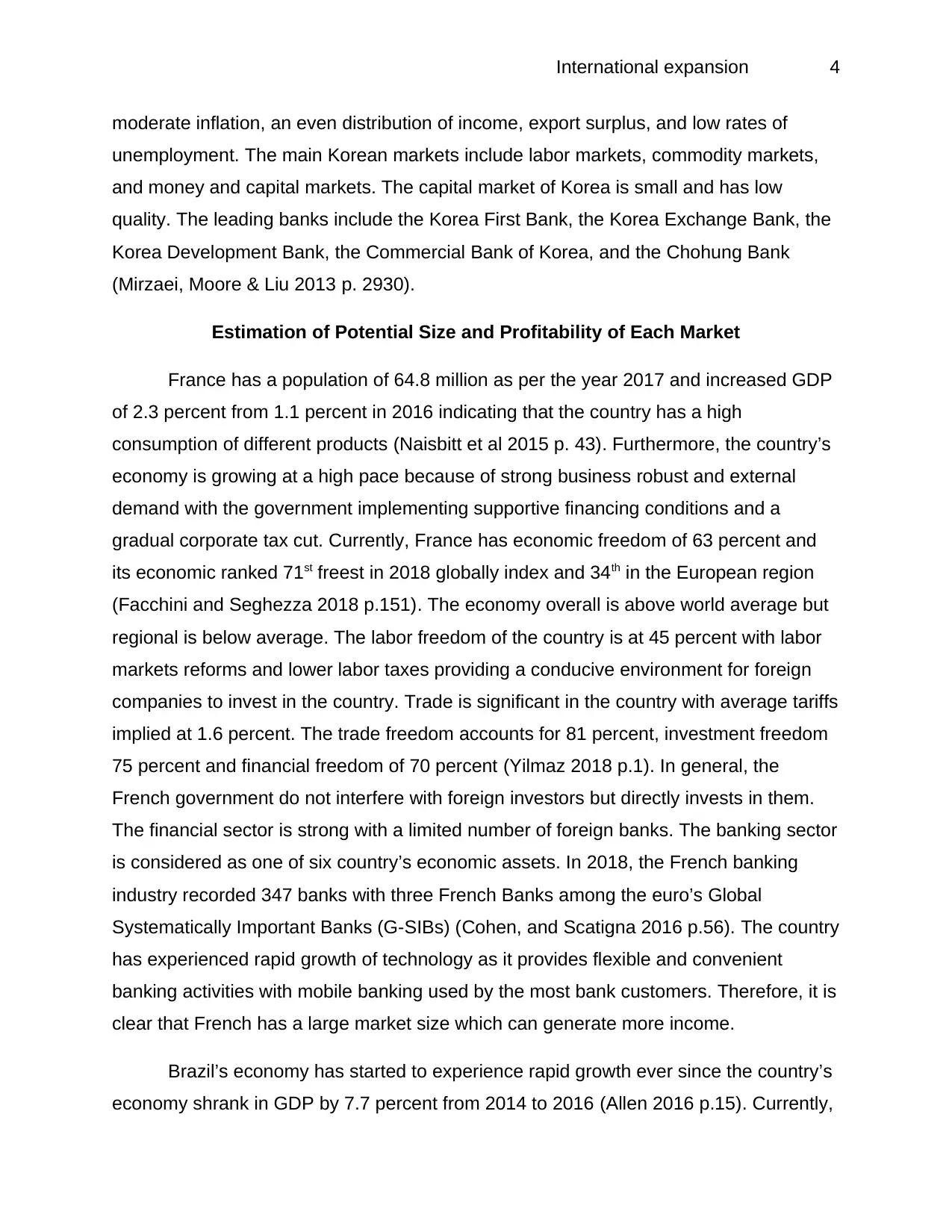
International expansion 4
moderate inflation, an even distribution of income, export surplus, and low rates of
unemployment. The main Korean markets include labor markets, commodity markets,
and money and capital markets. The capital market of Korea is small and has low
quality. The leading banks include the Korea First Bank, the Korea Exchange Bank, the
Korea Development Bank, the Commercial Bank of Korea, and the Chohung Bank
(Mirzaei, Moore & Liu 2013 p. 2930).
Estimation of Potential Size and Profitability of Each Market
France has a population of 64.8 million as per the year 2017 and increased GDP
of 2.3 percent from 1.1 percent in 2016 indicating that the country has a high
consumption of different products (Naisbitt et al 2015 p. 43). Furthermore, the country’s
economy is growing at a high pace because of strong business robust and external
demand with the government implementing supportive financing conditions and a
gradual corporate tax cut. Currently, France has economic freedom of 63 percent and
its economic ranked 71st freest in 2018 globally index and 34th in the European region
(Facchini and Seghezza 2018 p.151). The economy overall is above world average but
regional is below average. The labor freedom of the country is at 45 percent with labor
markets reforms and lower labor taxes providing a conducive environment for foreign
companies to invest in the country. Trade is significant in the country with average tariffs
implied at 1.6 percent. The trade freedom accounts for 81 percent, investment freedom
75 percent and financial freedom of 70 percent (Yilmaz 2018 p.1). In general, the
French government do not interfere with foreign investors but directly invests in them.
The financial sector is strong with a limited number of foreign banks. The banking sector
is considered as one of six country’s economic assets. In 2018, the French banking
industry recorded 347 banks with three French Banks among the euro’s Global
Systematically Important Banks (G-SIBs) (Cohen, and Scatigna 2016 p.56). The country
has experienced rapid growth of technology as it provides flexible and convenient
banking activities with mobile banking used by the most bank customers. Therefore, it is
clear that French has a large market size which can generate more income.
Brazil’s economy has started to experience rapid growth ever since the country’s
economy shrank in GDP by 7.7 percent from 2014 to 2016 (Allen 2016 p.15). Currently,
moderate inflation, an even distribution of income, export surplus, and low rates of
unemployment. The main Korean markets include labor markets, commodity markets,
and money and capital markets. The capital market of Korea is small and has low
quality. The leading banks include the Korea First Bank, the Korea Exchange Bank, the
Korea Development Bank, the Commercial Bank of Korea, and the Chohung Bank
(Mirzaei, Moore & Liu 2013 p. 2930).
Estimation of Potential Size and Profitability of Each Market
France has a population of 64.8 million as per the year 2017 and increased GDP
of 2.3 percent from 1.1 percent in 2016 indicating that the country has a high
consumption of different products (Naisbitt et al 2015 p. 43). Furthermore, the country’s
economy is growing at a high pace because of strong business robust and external
demand with the government implementing supportive financing conditions and a
gradual corporate tax cut. Currently, France has economic freedom of 63 percent and
its economic ranked 71st freest in 2018 globally index and 34th in the European region
(Facchini and Seghezza 2018 p.151). The economy overall is above world average but
regional is below average. The labor freedom of the country is at 45 percent with labor
markets reforms and lower labor taxes providing a conducive environment for foreign
companies to invest in the country. Trade is significant in the country with average tariffs
implied at 1.6 percent. The trade freedom accounts for 81 percent, investment freedom
75 percent and financial freedom of 70 percent (Yilmaz 2018 p.1). In general, the
French government do not interfere with foreign investors but directly invests in them.
The financial sector is strong with a limited number of foreign banks. The banking sector
is considered as one of six country’s economic assets. In 2018, the French banking
industry recorded 347 banks with three French Banks among the euro’s Global
Systematically Important Banks (G-SIBs) (Cohen, and Scatigna 2016 p.56). The country
has experienced rapid growth of technology as it provides flexible and convenient
banking activities with mobile banking used by the most bank customers. Therefore, it is
clear that French has a large market size which can generate more income.
Brazil’s economy has started to experience rapid growth ever since the country’s
economy shrank in GDP by 7.7 percent from 2014 to 2016 (Allen 2016 p.15). Currently,
Paraphrase This Document
Need a fresh take? Get an instant paraphrase of this document with our AI Paraphraser
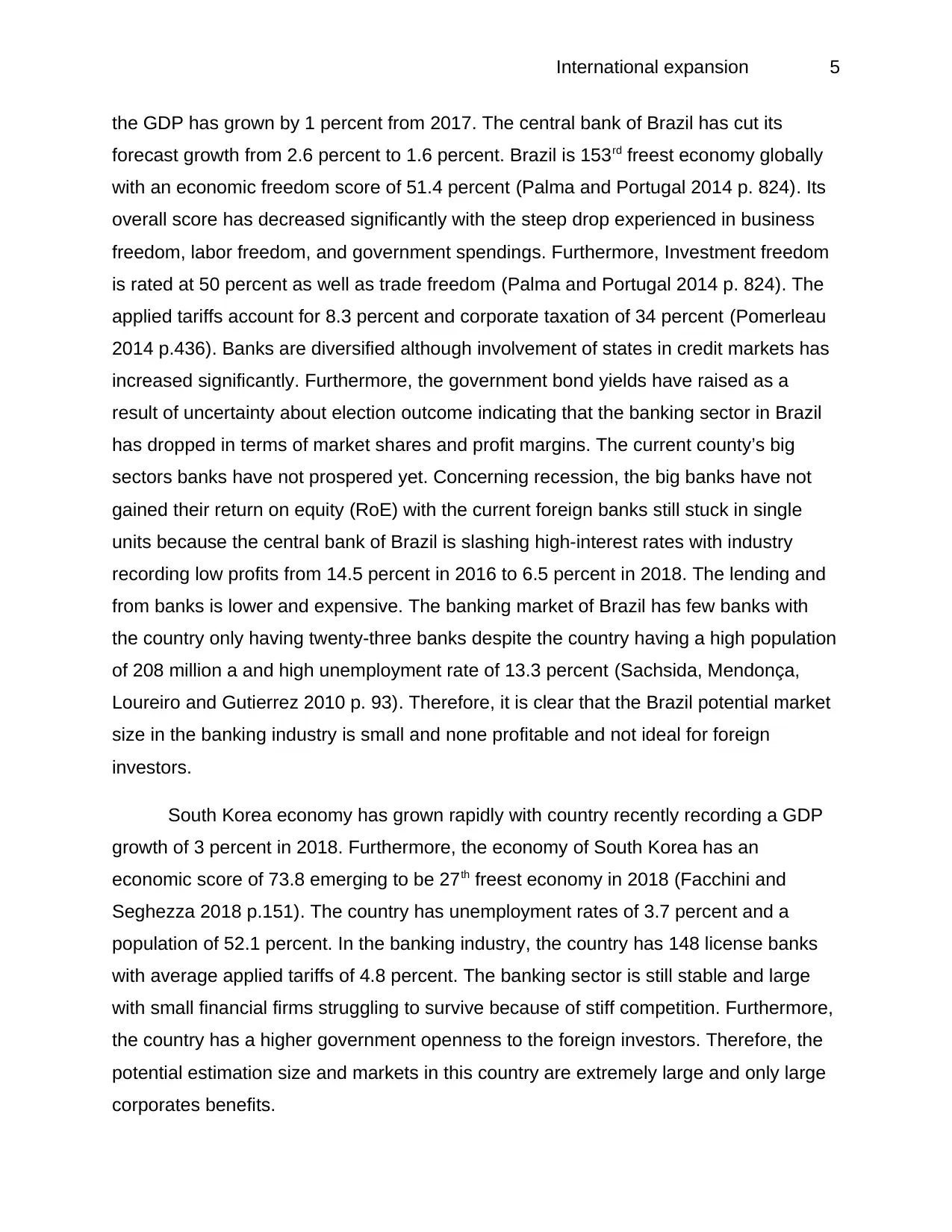
International expansion 5
the GDP has grown by 1 percent from 2017. The central bank of Brazil has cut its
forecast growth from 2.6 percent to 1.6 percent. Brazil is 153rd freest economy globally
with an economic freedom score of 51.4 percent (Palma and Portugal 2014 p. 824). Its
overall score has decreased significantly with the steep drop experienced in business
freedom, labor freedom, and government spendings. Furthermore, Investment freedom
is rated at 50 percent as well as trade freedom (Palma and Portugal 2014 p. 824). The
applied tariffs account for 8.3 percent and corporate taxation of 34 percent (Pomerleau
2014 p.436). Banks are diversified although involvement of states in credit markets has
increased significantly. Furthermore, the government bond yields have raised as a
result of uncertainty about election outcome indicating that the banking sector in Brazil
has dropped in terms of market shares and profit margins. The current county’s big
sectors banks have not prospered yet. Concerning recession, the big banks have not
gained their return on equity (RoE) with the current foreign banks still stuck in single
units because the central bank of Brazil is slashing high-interest rates with industry
recording low profits from 14.5 percent in 2016 to 6.5 percent in 2018. The lending and
from banks is lower and expensive. The banking market of Brazil has few banks with
the country only having twenty-three banks despite the country having a high population
of 208 million a and high unemployment rate of 13.3 percent (Sachsida, Mendonça,
Loureiro and Gutierrez 2010 p. 93). Therefore, it is clear that the Brazil potential market
size in the banking industry is small and none profitable and not ideal for foreign
investors.
South Korea economy has grown rapidly with country recently recording a GDP
growth of 3 percent in 2018. Furthermore, the economy of South Korea has an
economic score of 73.8 emerging to be 27th freest economy in 2018 (Facchini and
Seghezza 2018 p.151). The country has unemployment rates of 3.7 percent and a
population of 52.1 percent. In the banking industry, the country has 148 license banks
with average applied tariffs of 4.8 percent. The banking sector is still stable and large
with small financial firms struggling to survive because of stiff competition. Furthermore,
the country has a higher government openness to the foreign investors. Therefore, the
potential estimation size and markets in this country are extremely large and only large
corporates benefits.
the GDP has grown by 1 percent from 2017. The central bank of Brazil has cut its
forecast growth from 2.6 percent to 1.6 percent. Brazil is 153rd freest economy globally
with an economic freedom score of 51.4 percent (Palma and Portugal 2014 p. 824). Its
overall score has decreased significantly with the steep drop experienced in business
freedom, labor freedom, and government spendings. Furthermore, Investment freedom
is rated at 50 percent as well as trade freedom (Palma and Portugal 2014 p. 824). The
applied tariffs account for 8.3 percent and corporate taxation of 34 percent (Pomerleau
2014 p.436). Banks are diversified although involvement of states in credit markets has
increased significantly. Furthermore, the government bond yields have raised as a
result of uncertainty about election outcome indicating that the banking sector in Brazil
has dropped in terms of market shares and profit margins. The current county’s big
sectors banks have not prospered yet. Concerning recession, the big banks have not
gained their return on equity (RoE) with the current foreign banks still stuck in single
units because the central bank of Brazil is slashing high-interest rates with industry
recording low profits from 14.5 percent in 2016 to 6.5 percent in 2018. The lending and
from banks is lower and expensive. The banking market of Brazil has few banks with
the country only having twenty-three banks despite the country having a high population
of 208 million a and high unemployment rate of 13.3 percent (Sachsida, Mendonça,
Loureiro and Gutierrez 2010 p. 93). Therefore, it is clear that the Brazil potential market
size in the banking industry is small and none profitable and not ideal for foreign
investors.
South Korea economy has grown rapidly with country recently recording a GDP
growth of 3 percent in 2018. Furthermore, the economy of South Korea has an
economic score of 73.8 emerging to be 27th freest economy in 2018 (Facchini and
Seghezza 2018 p.151). The country has unemployment rates of 3.7 percent and a
population of 52.1 percent. In the banking industry, the country has 148 license banks
with average applied tariffs of 4.8 percent. The banking sector is still stable and large
with small financial firms struggling to survive because of stiff competition. Furthermore,
the country has a higher government openness to the foreign investors. Therefore, the
potential estimation size and markets in this country are extremely large and only large
corporates benefits.
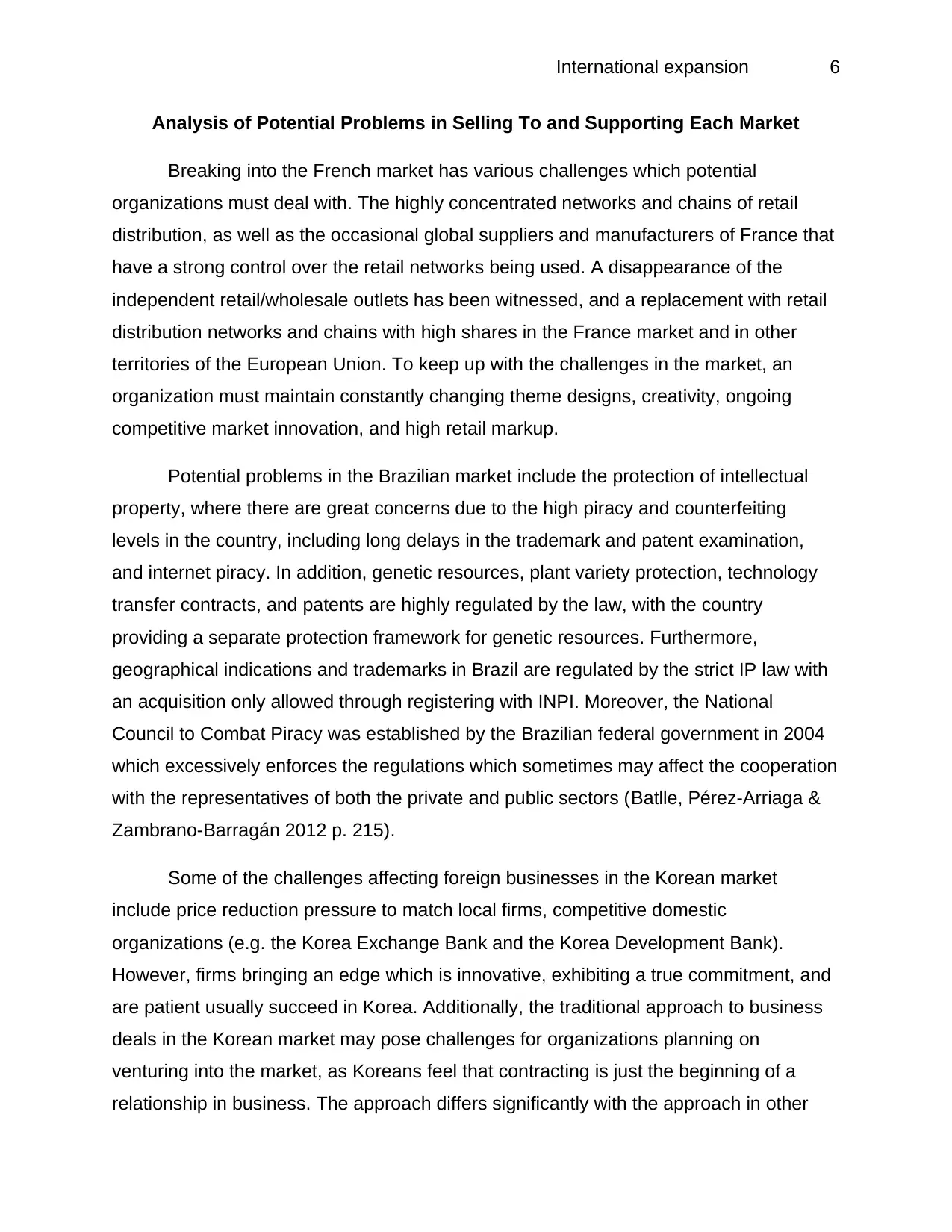
International expansion 6
Analysis of Potential Problems in Selling To and Supporting Each Market
Breaking into the French market has various challenges which potential
organizations must deal with. The highly concentrated networks and chains of retail
distribution, as well as the occasional global suppliers and manufacturers of France that
have a strong control over the retail networks being used. A disappearance of the
independent retail/wholesale outlets has been witnessed, and a replacement with retail
distribution networks and chains with high shares in the France market and in other
territories of the European Union. To keep up with the challenges in the market, an
organization must maintain constantly changing theme designs, creativity, ongoing
competitive market innovation, and high retail markup.
Potential problems in the Brazilian market include the protection of intellectual
property, where there are great concerns due to the high piracy and counterfeiting
levels in the country, including long delays in the trademark and patent examination,
and internet piracy. In addition, genetic resources, plant variety protection, technology
transfer contracts, and patents are highly regulated by the law, with the country
providing a separate protection framework for genetic resources. Furthermore,
geographical indications and trademarks in Brazil are regulated by the strict IP law with
an acquisition only allowed through registering with INPI. Moreover, the National
Council to Combat Piracy was established by the Brazilian federal government in 2004
which excessively enforces the regulations which sometimes may affect the cooperation
with the representatives of both the private and public sectors (Batlle, Pérez-Arriaga &
Zambrano-Barragán 2012 p. 215).
Some of the challenges affecting foreign businesses in the Korean market
include price reduction pressure to match local firms, competitive domestic
organizations (e.g. the Korea Exchange Bank and the Korea Development Bank).
However, firms bringing an edge which is innovative, exhibiting a true commitment, and
are patient usually succeed in Korea. Additionally, the traditional approach to business
deals in the Korean market may pose challenges for organizations planning on
venturing into the market, as Koreans feel that contracting is just the beginning of a
relationship in business. The approach differs significantly with the approach in other
Analysis of Potential Problems in Selling To and Supporting Each Market
Breaking into the French market has various challenges which potential
organizations must deal with. The highly concentrated networks and chains of retail
distribution, as well as the occasional global suppliers and manufacturers of France that
have a strong control over the retail networks being used. A disappearance of the
independent retail/wholesale outlets has been witnessed, and a replacement with retail
distribution networks and chains with high shares in the France market and in other
territories of the European Union. To keep up with the challenges in the market, an
organization must maintain constantly changing theme designs, creativity, ongoing
competitive market innovation, and high retail markup.
Potential problems in the Brazilian market include the protection of intellectual
property, where there are great concerns due to the high piracy and counterfeiting
levels in the country, including long delays in the trademark and patent examination,
and internet piracy. In addition, genetic resources, plant variety protection, technology
transfer contracts, and patents are highly regulated by the law, with the country
providing a separate protection framework for genetic resources. Furthermore,
geographical indications and trademarks in Brazil are regulated by the strict IP law with
an acquisition only allowed through registering with INPI. Moreover, the National
Council to Combat Piracy was established by the Brazilian federal government in 2004
which excessively enforces the regulations which sometimes may affect the cooperation
with the representatives of both the private and public sectors (Batlle, Pérez-Arriaga &
Zambrano-Barragán 2012 p. 215).
Some of the challenges affecting foreign businesses in the Korean market
include price reduction pressure to match local firms, competitive domestic
organizations (e.g. the Korea Exchange Bank and the Korea Development Bank).
However, firms bringing an edge which is innovative, exhibiting a true commitment, and
are patient usually succeed in Korea. Additionally, the traditional approach to business
deals in the Korean market may pose challenges for organizations planning on
venturing into the market, as Koreans feel that contracting is just the beginning of a
relationship in business. The approach differs significantly with the approach in other
⊘ This is a preview!⊘
Do you want full access?
Subscribe today to unlock all pages.

Trusted by 1+ million students worldwide
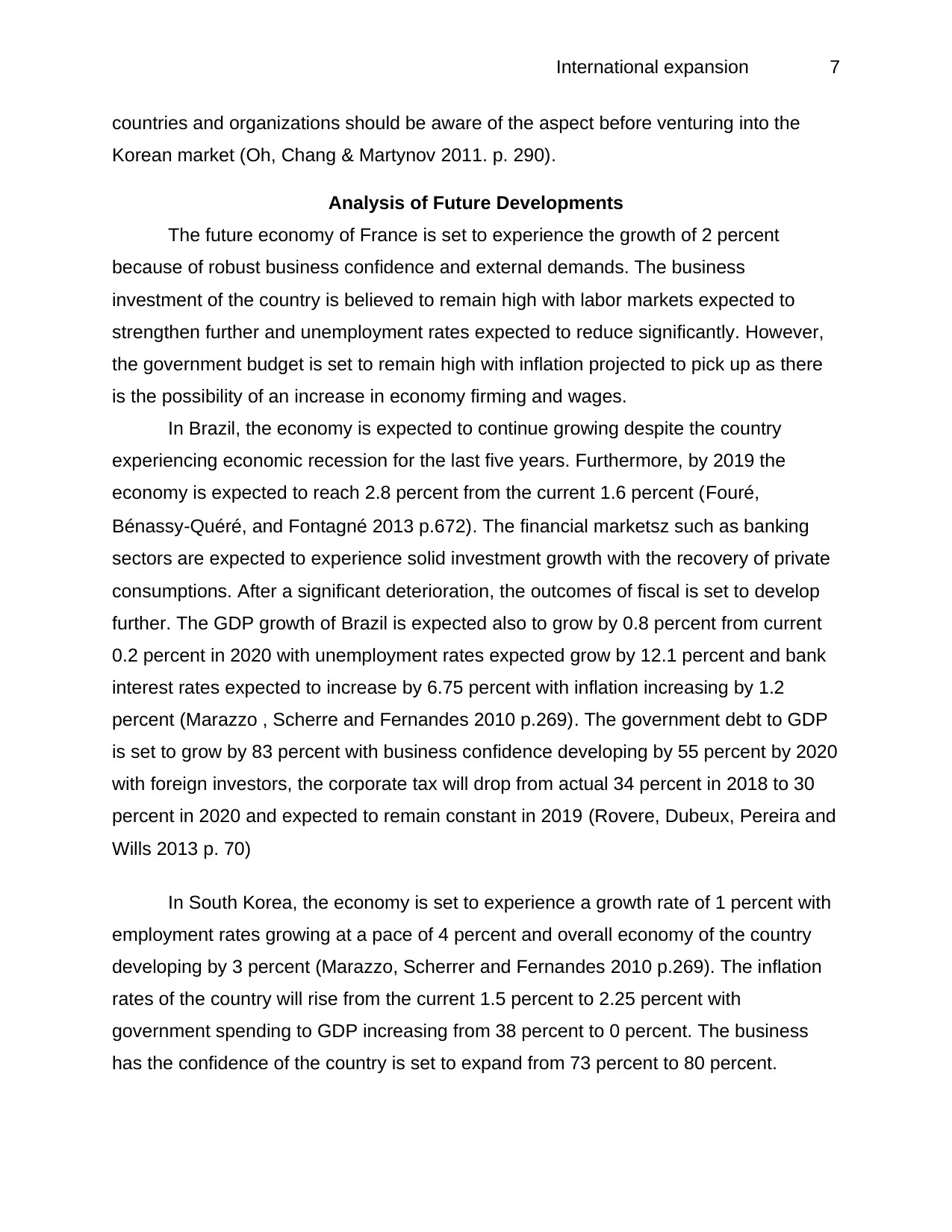
International expansion 7
countries and organizations should be aware of the aspect before venturing into the
Korean market (Oh, Chang & Martynov 2011. p. 290).
Analysis of Future Developments
The future economy of France is set to experience the growth of 2 percent
because of robust business confidence and external demands. The business
investment of the country is believed to remain high with labor markets expected to
strengthen further and unemployment rates expected to reduce significantly. However,
the government budget is set to remain high with inflation projected to pick up as there
is the possibility of an increase in economy firming and wages.
In Brazil, the economy is expected to continue growing despite the country
experiencing economic recession for the last five years. Furthermore, by 2019 the
economy is expected to reach 2.8 percent from the current 1.6 percent (Fouré,
Bénassy‐Quéré, and Fontagné 2013 p.672). The financial marketsz such as banking
sectors are expected to experience solid investment growth with the recovery of private
consumptions. After a significant deterioration, the outcomes of fiscal is set to develop
further. The GDP growth of Brazil is expected also to grow by 0.8 percent from current
0.2 percent in 2020 with unemployment rates expected grow by 12.1 percent and bank
interest rates expected to increase by 6.75 percent with inflation increasing by 1.2
percent (Marazzo , Scherre and Fernandes 2010 p.269). The government debt to GDP
is set to grow by 83 percent with business confidence developing by 55 percent by 2020
with foreign investors, the corporate tax will drop from actual 34 percent in 2018 to 30
percent in 2020 and expected to remain constant in 2019 (Rovere, Dubeux, Pereira and
Wills 2013 p. 70)
In South Korea, the economy is set to experience a growth rate of 1 percent with
employment rates growing at a pace of 4 percent and overall economy of the country
developing by 3 percent (Marazzo, Scherrer and Fernandes 2010 p.269). The inflation
rates of the country will rise from the current 1.5 percent to 2.25 percent with
government spending to GDP increasing from 38 percent to 0 percent. The business
has the confidence of the country is set to expand from 73 percent to 80 percent.
countries and organizations should be aware of the aspect before venturing into the
Korean market (Oh, Chang & Martynov 2011. p. 290).
Analysis of Future Developments
The future economy of France is set to experience the growth of 2 percent
because of robust business confidence and external demands. The business
investment of the country is believed to remain high with labor markets expected to
strengthen further and unemployment rates expected to reduce significantly. However,
the government budget is set to remain high with inflation projected to pick up as there
is the possibility of an increase in economy firming and wages.
In Brazil, the economy is expected to continue growing despite the country
experiencing economic recession for the last five years. Furthermore, by 2019 the
economy is expected to reach 2.8 percent from the current 1.6 percent (Fouré,
Bénassy‐Quéré, and Fontagné 2013 p.672). The financial marketsz such as banking
sectors are expected to experience solid investment growth with the recovery of private
consumptions. After a significant deterioration, the outcomes of fiscal is set to develop
further. The GDP growth of Brazil is expected also to grow by 0.8 percent from current
0.2 percent in 2020 with unemployment rates expected grow by 12.1 percent and bank
interest rates expected to increase by 6.75 percent with inflation increasing by 1.2
percent (Marazzo , Scherre and Fernandes 2010 p.269). The government debt to GDP
is set to grow by 83 percent with business confidence developing by 55 percent by 2020
with foreign investors, the corporate tax will drop from actual 34 percent in 2018 to 30
percent in 2020 and expected to remain constant in 2019 (Rovere, Dubeux, Pereira and
Wills 2013 p. 70)
In South Korea, the economy is set to experience a growth rate of 1 percent with
employment rates growing at a pace of 4 percent and overall economy of the country
developing by 3 percent (Marazzo, Scherrer and Fernandes 2010 p.269). The inflation
rates of the country will rise from the current 1.5 percent to 2.25 percent with
government spending to GDP increasing from 38 percent to 0 percent. The business
has the confidence of the country is set to expand from 73 percent to 80 percent.
Paraphrase This Document
Need a fresh take? Get an instant paraphrase of this document with our AI Paraphraser
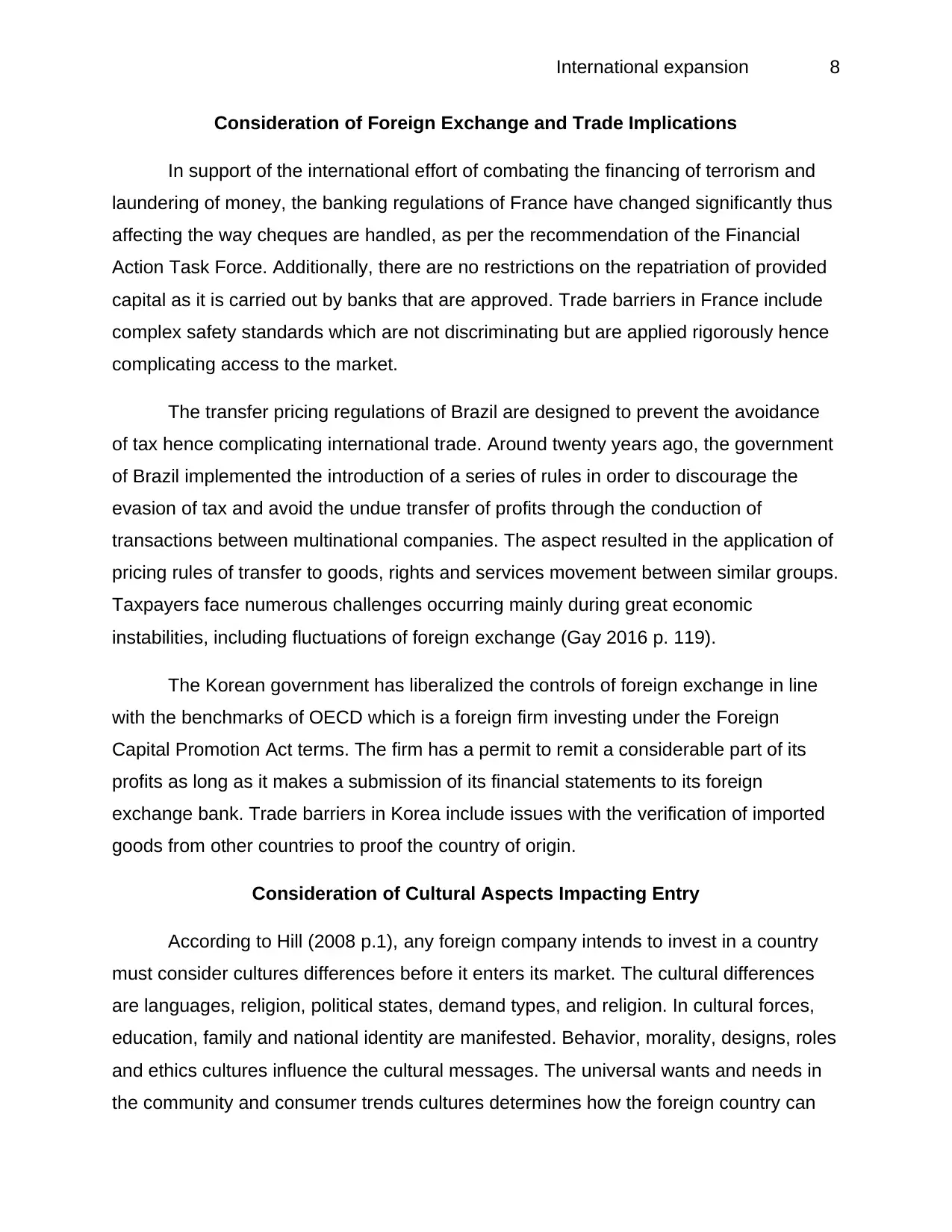
International expansion 8
Consideration of Foreign Exchange and Trade Implications
In support of the international effort of combating the financing of terrorism and
laundering of money, the banking regulations of France have changed significantly thus
affecting the way cheques are handled, as per the recommendation of the Financial
Action Task Force. Additionally, there are no restrictions on the repatriation of provided
capital as it is carried out by banks that are approved. Trade barriers in France include
complex safety standards which are not discriminating but are applied rigorously hence
complicating access to the market.
The transfer pricing regulations of Brazil are designed to prevent the avoidance
of tax hence complicating international trade. Around twenty years ago, the government
of Brazil implemented the introduction of a series of rules in order to discourage the
evasion of tax and avoid the undue transfer of profits through the conduction of
transactions between multinational companies. The aspect resulted in the application of
pricing rules of transfer to goods, rights and services movement between similar groups.
Taxpayers face numerous challenges occurring mainly during great economic
instabilities, including fluctuations of foreign exchange (Gay 2016 p. 119).
The Korean government has liberalized the controls of foreign exchange in line
with the benchmarks of OECD which is a foreign firm investing under the Foreign
Capital Promotion Act terms. The firm has a permit to remit a considerable part of its
profits as long as it makes a submission of its financial statements to its foreign
exchange bank. Trade barriers in Korea include issues with the verification of imported
goods from other countries to proof the country of origin.
Consideration of Cultural Aspects Impacting Entry
According to Hill (2008 p.1), any foreign company intends to invest in a country
must consider cultures differences before it enters its market. The cultural differences
are languages, religion, political states, demand types, and religion. In cultural forces,
education, family and national identity are manifested. Behavior, morality, designs, roles
and ethics cultures influence the cultural messages. The universal wants and needs in
the community and consumer trends cultures determines how the foreign country can
Consideration of Foreign Exchange and Trade Implications
In support of the international effort of combating the financing of terrorism and
laundering of money, the banking regulations of France have changed significantly thus
affecting the way cheques are handled, as per the recommendation of the Financial
Action Task Force. Additionally, there are no restrictions on the repatriation of provided
capital as it is carried out by banks that are approved. Trade barriers in France include
complex safety standards which are not discriminating but are applied rigorously hence
complicating access to the market.
The transfer pricing regulations of Brazil are designed to prevent the avoidance
of tax hence complicating international trade. Around twenty years ago, the government
of Brazil implemented the introduction of a series of rules in order to discourage the
evasion of tax and avoid the undue transfer of profits through the conduction of
transactions between multinational companies. The aspect resulted in the application of
pricing rules of transfer to goods, rights and services movement between similar groups.
Taxpayers face numerous challenges occurring mainly during great economic
instabilities, including fluctuations of foreign exchange (Gay 2016 p. 119).
The Korean government has liberalized the controls of foreign exchange in line
with the benchmarks of OECD which is a foreign firm investing under the Foreign
Capital Promotion Act terms. The firm has a permit to remit a considerable part of its
profits as long as it makes a submission of its financial statements to its foreign
exchange bank. Trade barriers in Korea include issues with the verification of imported
goods from other countries to proof the country of origin.
Consideration of Cultural Aspects Impacting Entry
According to Hill (2008 p.1), any foreign company intends to invest in a country
must consider cultures differences before it enters its market. The cultural differences
are languages, religion, political states, demand types, and religion. In cultural forces,
education, family and national identity are manifested. Behavior, morality, designs, roles
and ethics cultures influence the cultural messages. The universal wants and needs in
the community and consumer trends cultures determines how the foreign country can
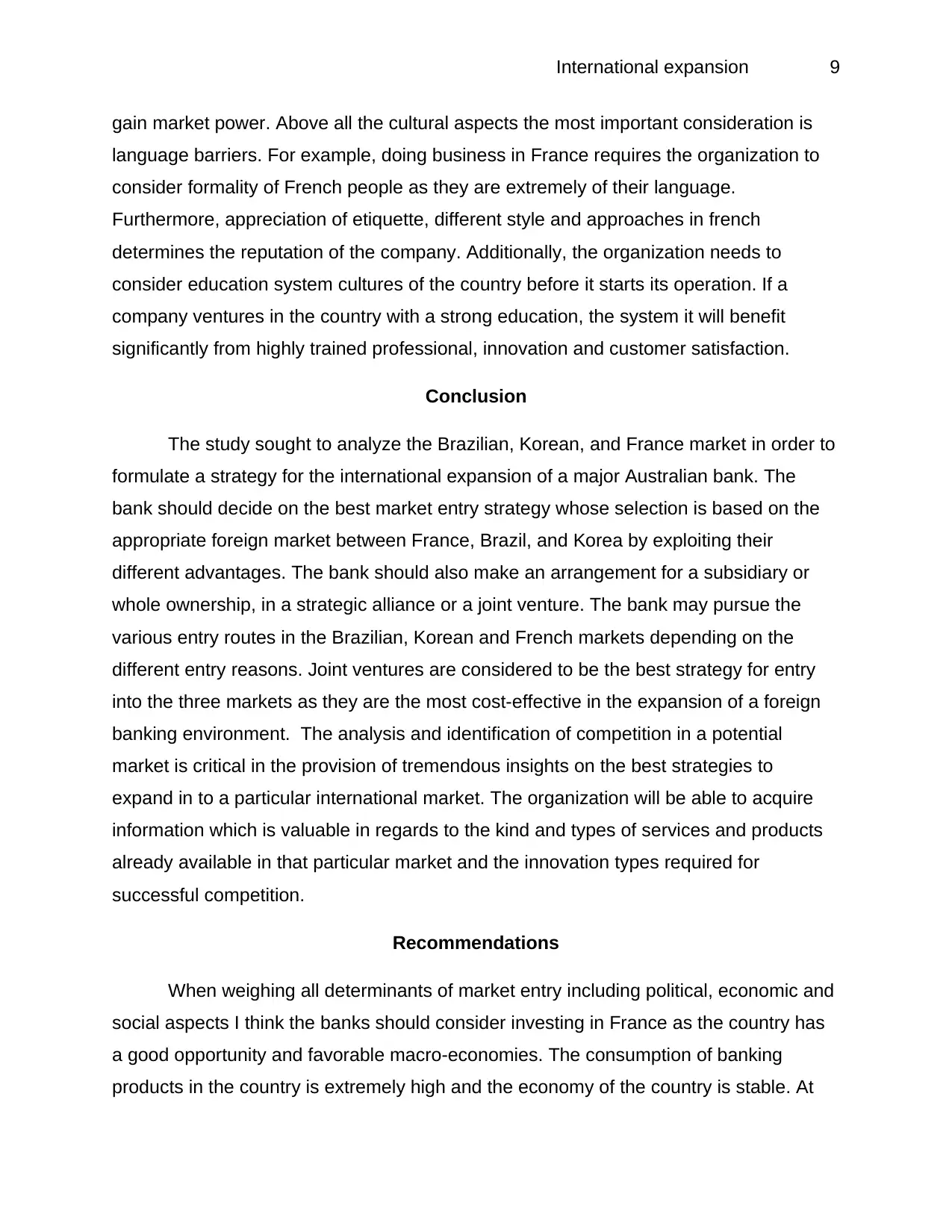
International expansion 9
gain market power. Above all the cultural aspects the most important consideration is
language barriers. For example, doing business in France requires the organization to
consider formality of French people as they are extremely of their language.
Furthermore, appreciation of etiquette, different style and approaches in french
determines the reputation of the company. Additionally, the organization needs to
consider education system cultures of the country before it starts its operation. If a
company ventures in the country with a strong education, the system it will benefit
significantly from highly trained professional, innovation and customer satisfaction.
Conclusion
The study sought to analyze the Brazilian, Korean, and France market in order to
formulate a strategy for the international expansion of a major Australian bank. The
bank should decide on the best market entry strategy whose selection is based on the
appropriate foreign market between France, Brazil, and Korea by exploiting their
different advantages. The bank should also make an arrangement for a subsidiary or
whole ownership, in a strategic alliance or a joint venture. The bank may pursue the
various entry routes in the Brazilian, Korean and French markets depending on the
different entry reasons. Joint ventures are considered to be the best strategy for entry
into the three markets as they are the most cost-effective in the expansion of a foreign
banking environment. The analysis and identification of competition in a potential
market is critical in the provision of tremendous insights on the best strategies to
expand in to a particular international market. The organization will be able to acquire
information which is valuable in regards to the kind and types of services and products
already available in that particular market and the innovation types required for
successful competition.
Recommendations
When weighing all determinants of market entry including political, economic and
social aspects I think the banks should consider investing in France as the country has
a good opportunity and favorable macro-economies. The consumption of banking
products in the country is extremely high and the economy of the country is stable. At
gain market power. Above all the cultural aspects the most important consideration is
language barriers. For example, doing business in France requires the organization to
consider formality of French people as they are extremely of their language.
Furthermore, appreciation of etiquette, different style and approaches in french
determines the reputation of the company. Additionally, the organization needs to
consider education system cultures of the country before it starts its operation. If a
company ventures in the country with a strong education, the system it will benefit
significantly from highly trained professional, innovation and customer satisfaction.
Conclusion
The study sought to analyze the Brazilian, Korean, and France market in order to
formulate a strategy for the international expansion of a major Australian bank. The
bank should decide on the best market entry strategy whose selection is based on the
appropriate foreign market between France, Brazil, and Korea by exploiting their
different advantages. The bank should also make an arrangement for a subsidiary or
whole ownership, in a strategic alliance or a joint venture. The bank may pursue the
various entry routes in the Brazilian, Korean and French markets depending on the
different entry reasons. Joint ventures are considered to be the best strategy for entry
into the three markets as they are the most cost-effective in the expansion of a foreign
banking environment. The analysis and identification of competition in a potential
market is critical in the provision of tremendous insights on the best strategies to
expand in to a particular international market. The organization will be able to acquire
information which is valuable in regards to the kind and types of services and products
already available in that particular market and the innovation types required for
successful competition.
Recommendations
When weighing all determinants of market entry including political, economic and
social aspects I think the banks should consider investing in France as the country has
a good opportunity and favorable macro-economies. The consumption of banking
products in the country is extremely high and the economy of the country is stable. At
⊘ This is a preview!⊘
Do you want full access?
Subscribe today to unlock all pages.

Trusted by 1+ million students worldwide
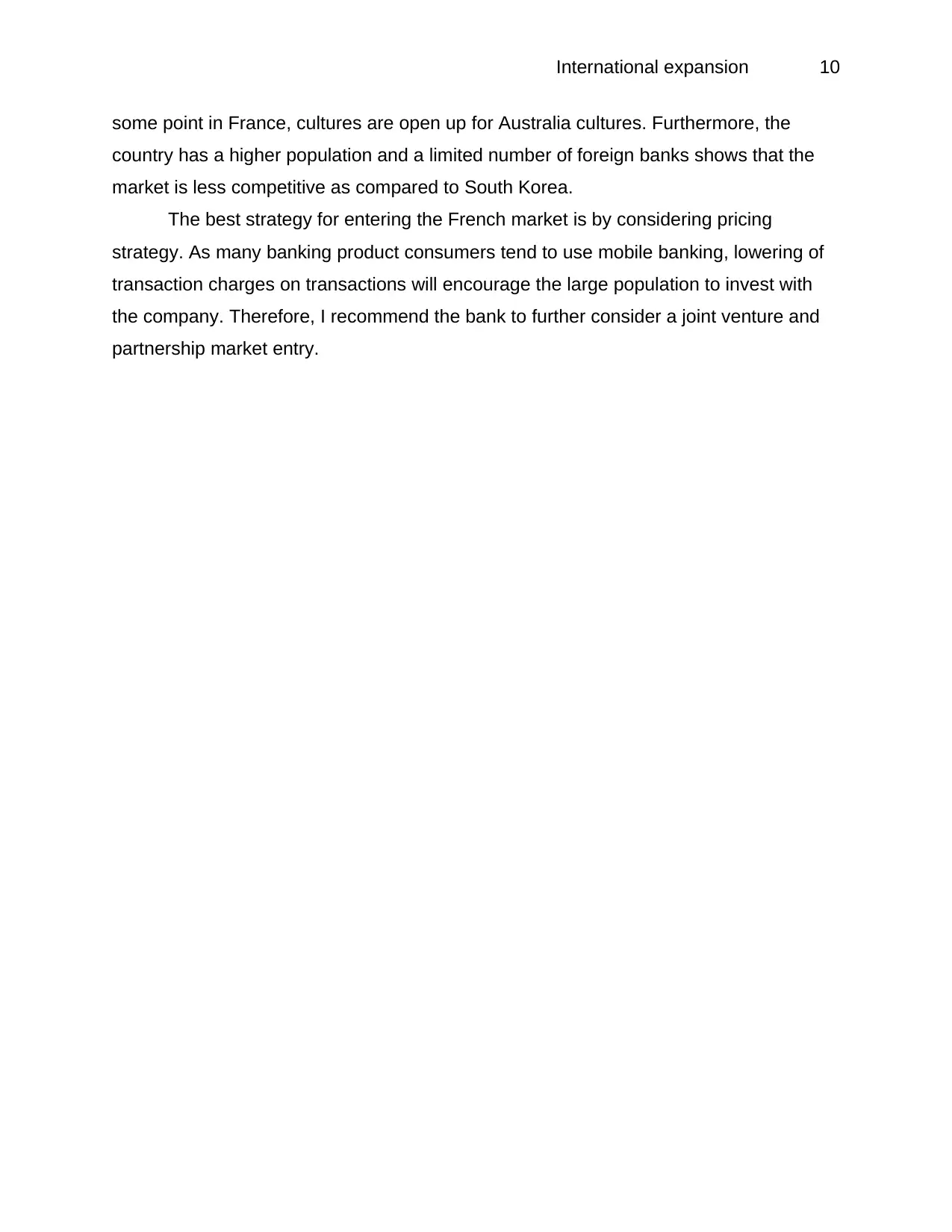
International expansion 10
some point in France, cultures are open up for Australia cultures. Furthermore, the
country has a higher population and a limited number of foreign banks shows that the
market is less competitive as compared to South Korea.
The best strategy for entering the French market is by considering pricing
strategy. As many banking product consumers tend to use mobile banking, lowering of
transaction charges on transactions will encourage the large population to invest with
the company. Therefore, I recommend the bank to further consider a joint venture and
partnership market entry.
some point in France, cultures are open up for Australia cultures. Furthermore, the
country has a higher population and a limited number of foreign banks shows that the
market is less competitive as compared to South Korea.
The best strategy for entering the French market is by considering pricing
strategy. As many banking product consumers tend to use mobile banking, lowering of
transaction charges on transactions will encourage the large population to invest with
the company. Therefore, I recommend the bank to further consider a joint venture and
partnership market entry.
Paraphrase This Document
Need a fresh take? Get an instant paraphrase of this document with our AI Paraphraser
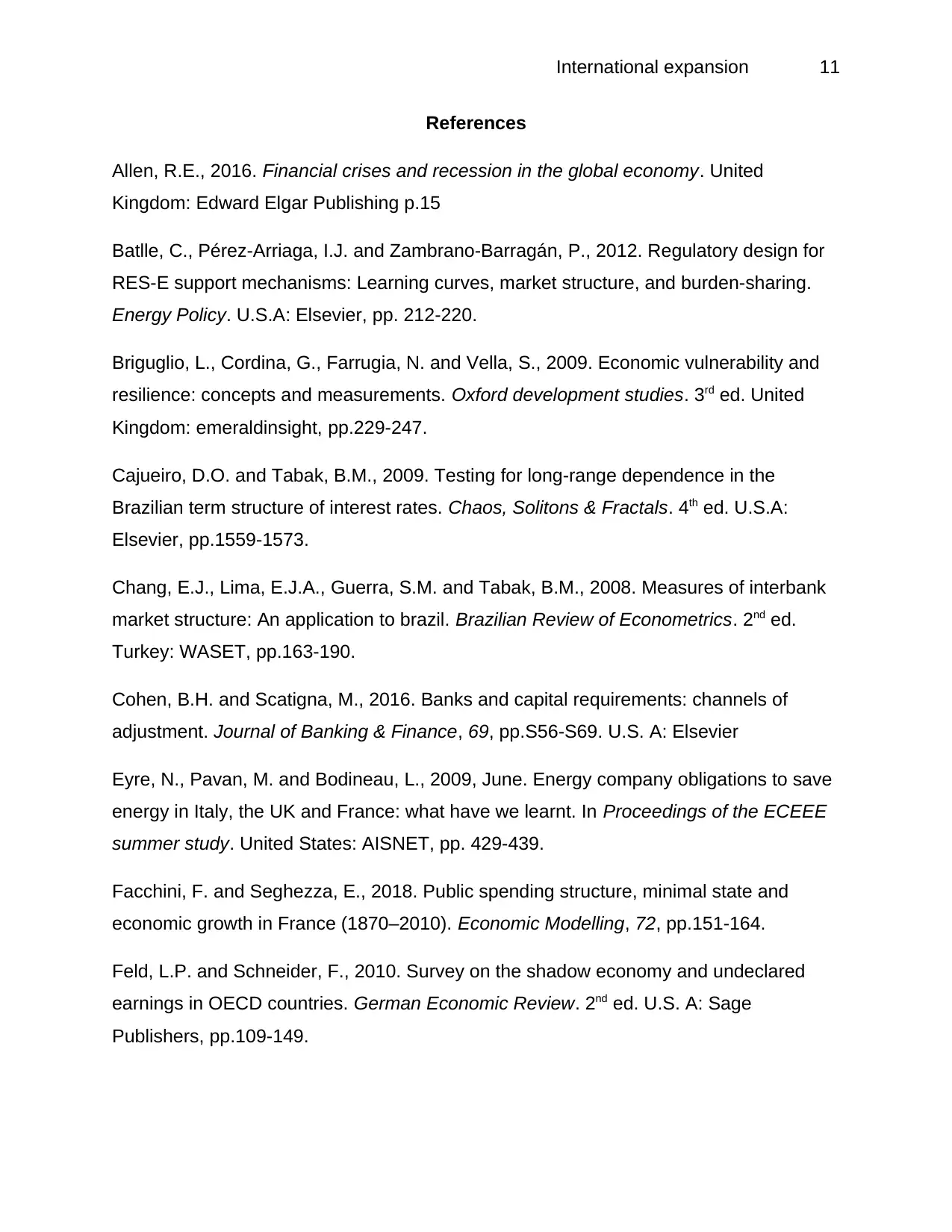
International expansion 11
References
Allen, R.E., 2016. Financial crises and recession in the global economy. United
Kingdom: Edward Elgar Publishing p.15
Batlle, C., Pérez-Arriaga, I.J. and Zambrano-Barragán, P., 2012. Regulatory design for
RES-E support mechanisms: Learning curves, market structure, and burden-sharing.
Energy Policy. U.S.A: Elsevier, pp. 212-220.
Briguglio, L., Cordina, G., Farrugia, N. and Vella, S., 2009. Economic vulnerability and
resilience: concepts and measurements. Oxford development studies. 3rd ed. United
Kingdom: emeraldinsight, pp.229-247.
Cajueiro, D.O. and Tabak, B.M., 2009. Testing for long-range dependence in the
Brazilian term structure of interest rates. Chaos, Solitons & Fractals. 4th ed. U.S.A:
Elsevier, pp.1559-1573.
Chang, E.J., Lima, E.J.A., Guerra, S.M. and Tabak, B.M., 2008. Measures of interbank
market structure: An application to brazil. Brazilian Review of Econometrics. 2nd ed.
Turkey: WASET, pp.163-190.
Cohen, B.H. and Scatigna, M., 2016. Banks and capital requirements: channels of
adjustment. Journal of Banking & Finance, 69, pp.S56-S69. U.S. A: Elsevier
Eyre, N., Pavan, M. and Bodineau, L., 2009, June. Energy company obligations to save
energy in Italy, the UK and France: what have we learnt. In Proceedings of the ECEEE
summer study. United States: AISNET, pp. 429-439.
Facchini, F. and Seghezza, E., 2018. Public spending structure, minimal state and
economic growth in France (1870–2010). Economic Modelling, 72, pp.151-164.
Feld, L.P. and Schneider, F., 2010. Survey on the shadow economy and undeclared
earnings in OECD countries. German Economic Review. 2nd ed. U.S. A: Sage
Publishers, pp.109-149.
References
Allen, R.E., 2016. Financial crises and recession in the global economy. United
Kingdom: Edward Elgar Publishing p.15
Batlle, C., Pérez-Arriaga, I.J. and Zambrano-Barragán, P., 2012. Regulatory design for
RES-E support mechanisms: Learning curves, market structure, and burden-sharing.
Energy Policy. U.S.A: Elsevier, pp. 212-220.
Briguglio, L., Cordina, G., Farrugia, N. and Vella, S., 2009. Economic vulnerability and
resilience: concepts and measurements. Oxford development studies. 3rd ed. United
Kingdom: emeraldinsight, pp.229-247.
Cajueiro, D.O. and Tabak, B.M., 2009. Testing for long-range dependence in the
Brazilian term structure of interest rates. Chaos, Solitons & Fractals. 4th ed. U.S.A:
Elsevier, pp.1559-1573.
Chang, E.J., Lima, E.J.A., Guerra, S.M. and Tabak, B.M., 2008. Measures of interbank
market structure: An application to brazil. Brazilian Review of Econometrics. 2nd ed.
Turkey: WASET, pp.163-190.
Cohen, B.H. and Scatigna, M., 2016. Banks and capital requirements: channels of
adjustment. Journal of Banking & Finance, 69, pp.S56-S69. U.S. A: Elsevier
Eyre, N., Pavan, M. and Bodineau, L., 2009, June. Energy company obligations to save
energy in Italy, the UK and France: what have we learnt. In Proceedings of the ECEEE
summer study. United States: AISNET, pp. 429-439.
Facchini, F. and Seghezza, E., 2018. Public spending structure, minimal state and
economic growth in France (1870–2010). Economic Modelling, 72, pp.151-164.
Feld, L.P. and Schneider, F., 2010. Survey on the shadow economy and undeclared
earnings in OECD countries. German Economic Review. 2nd ed. U.S. A: Sage
Publishers, pp.109-149.
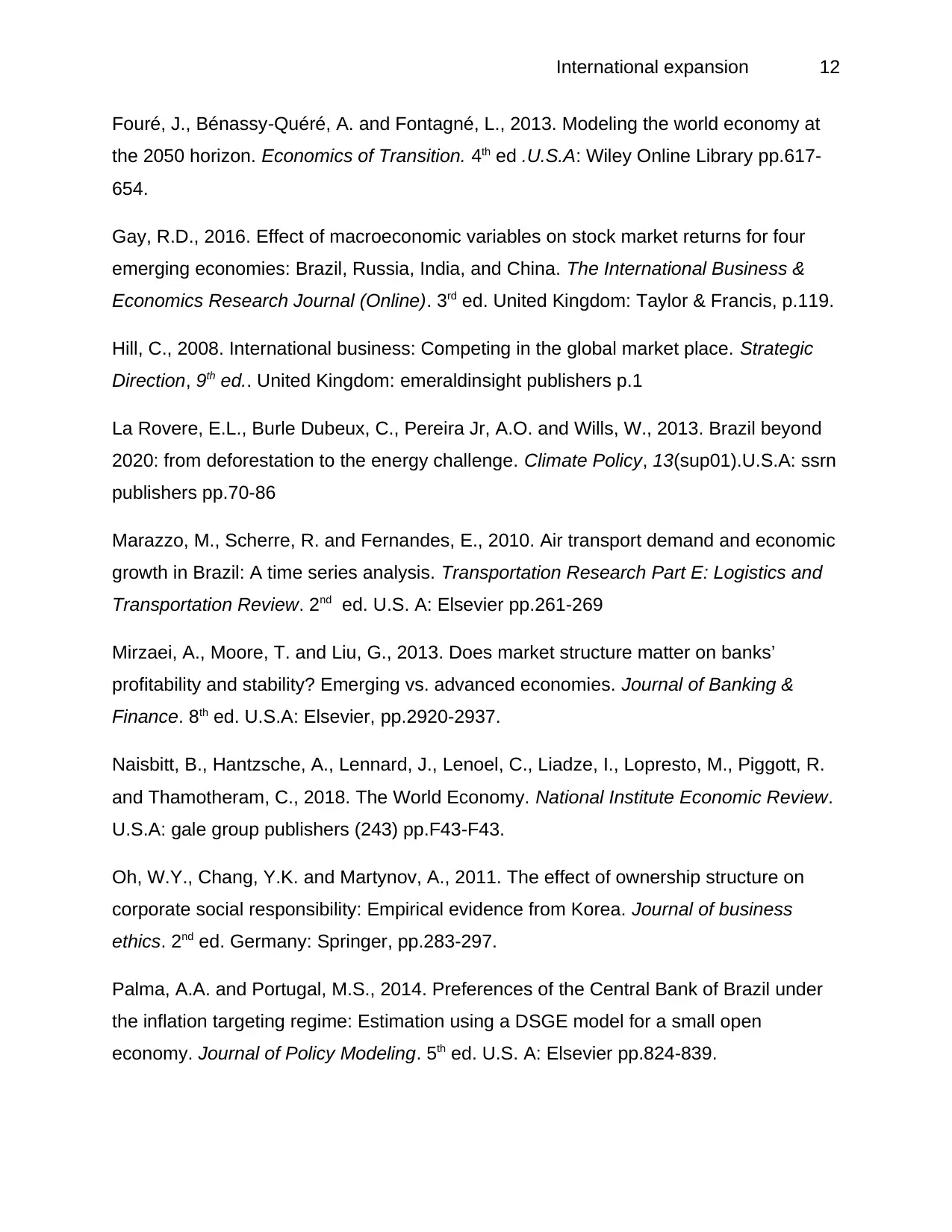
International expansion 12
Fouré, J., Bénassy‐Quéré, A. and Fontagné, L., 2013. Modeling the world economy at
the 2050 horizon. Economics of Transition. 4th ed .U.S.A: Wiley Online Library pp.617-
654.
Gay, R.D., 2016. Effect of macroeconomic variables on stock market returns for four
emerging economies: Brazil, Russia, India, and China. The International Business &
Economics Research Journal (Online). 3rd ed. United Kingdom: Taylor & Francis, p.119.
Hill, C., 2008. International business: Competing in the global market place. Strategic
Direction, 9th ed.. United Kingdom: emeraldinsight publishers p.1
La Rovere, E.L., Burle Dubeux, C., Pereira Jr, A.O. and Wills, W., 2013. Brazil beyond
2020: from deforestation to the energy challenge. Climate Policy, 13(sup01).U.S.A: ssrn
publishers pp.70-86
Marazzo, M., Scherre, R. and Fernandes, E., 2010. Air transport demand and economic
growth in Brazil: A time series analysis. Transportation Research Part E: Logistics and
Transportation Review. 2nd ed. U.S. A: Elsevier pp.261-269
Mirzaei, A., Moore, T. and Liu, G., 2013. Does market structure matter on banks’
profitability and stability? Emerging vs. advanced economies. Journal of Banking &
Finance. 8th ed. U.S.A: Elsevier, pp.2920-2937.
Naisbitt, B., Hantzsche, A., Lennard, J., Lenoel, C., Liadze, I., Lopresto, M., Piggott, R.
and Thamotheram, C., 2018. The World Economy. National Institute Economic Review.
U.S.A: gale group publishers (243) pp.F43-F43.
Oh, W.Y., Chang, Y.K. and Martynov, A., 2011. The effect of ownership structure on
corporate social responsibility: Empirical evidence from Korea. Journal of business
ethics. 2nd ed. Germany: Springer, pp.283-297.
Palma, A.A. and Portugal, M.S., 2014. Preferences of the Central Bank of Brazil under
the inflation targeting regime: Estimation using a DSGE model for a small open
economy. Journal of Policy Modeling. 5th ed. U.S. A: Elsevier pp.824-839.
Fouré, J., Bénassy‐Quéré, A. and Fontagné, L., 2013. Modeling the world economy at
the 2050 horizon. Economics of Transition. 4th ed .U.S.A: Wiley Online Library pp.617-
654.
Gay, R.D., 2016. Effect of macroeconomic variables on stock market returns for four
emerging economies: Brazil, Russia, India, and China. The International Business &
Economics Research Journal (Online). 3rd ed. United Kingdom: Taylor & Francis, p.119.
Hill, C., 2008. International business: Competing in the global market place. Strategic
Direction, 9th ed.. United Kingdom: emeraldinsight publishers p.1
La Rovere, E.L., Burle Dubeux, C., Pereira Jr, A.O. and Wills, W., 2013. Brazil beyond
2020: from deforestation to the energy challenge. Climate Policy, 13(sup01).U.S.A: ssrn
publishers pp.70-86
Marazzo, M., Scherre, R. and Fernandes, E., 2010. Air transport demand and economic
growth in Brazil: A time series analysis. Transportation Research Part E: Logistics and
Transportation Review. 2nd ed. U.S. A: Elsevier pp.261-269
Mirzaei, A., Moore, T. and Liu, G., 2013. Does market structure matter on banks’
profitability and stability? Emerging vs. advanced economies. Journal of Banking &
Finance. 8th ed. U.S.A: Elsevier, pp.2920-2937.
Naisbitt, B., Hantzsche, A., Lennard, J., Lenoel, C., Liadze, I., Lopresto, M., Piggott, R.
and Thamotheram, C., 2018. The World Economy. National Institute Economic Review.
U.S.A: gale group publishers (243) pp.F43-F43.
Oh, W.Y., Chang, Y.K. and Martynov, A., 2011. The effect of ownership structure on
corporate social responsibility: Empirical evidence from Korea. Journal of business
ethics. 2nd ed. Germany: Springer, pp.283-297.
Palma, A.A. and Portugal, M.S., 2014. Preferences of the Central Bank of Brazil under
the inflation targeting regime: Estimation using a DSGE model for a small open
economy. Journal of Policy Modeling. 5th ed. U.S. A: Elsevier pp.824-839.
⊘ This is a preview!⊘
Do you want full access?
Subscribe today to unlock all pages.

Trusted by 1+ million students worldwide
1 out of 13
Related Documents
Your All-in-One AI-Powered Toolkit for Academic Success.
+13062052269
info@desklib.com
Available 24*7 on WhatsApp / Email
![[object Object]](/_next/static/media/star-bottom.7253800d.svg)
Unlock your academic potential
Copyright © 2020–2025 A2Z Services. All Rights Reserved. Developed and managed by ZUCOL.



